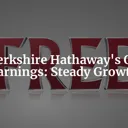Tags: McLane / earnings
This fanpage is not officially affiliated with Berkshire Hathaway: Disclaimer

Introduction
In the realm of wholesale distribution services, few companies possess the far-reaching impact and influence of McLane Company, Inc. As a leading distributor across all 50 states, McLane serves a diverse clientele that includes convenience stores, discount retailers, wholesale clubs, drug stores, military bases, quick service restaurants, and casual dining restaurants. In the grand tapestry of commerce, major customers often play a pivotal role in driving revenue growth. For McLane, the year 2022 proved no exception to this rule, with a triumvirate of giants – Walmart, 7-Eleven, and Yum! Brands – taking center stage.
In this article, we will explore the key factors that contributed to McLane's impressive revenue growth in 2022, delving into the company's relationship with these major customers, its business model, and the performance of its various units. Drawing from history, politics, and economics, we will present a thorough, interesting, and entertaining analysis that appeals to the discerning shareholders of Berkshire Hathaway, McLane's parent company.
So, without further ado, let's embark on this fascinating journey to understand the driving forces behind McLane's significant revenue growth in 2022.
The article is based on Berkshire Hathaway's 2022 annual report. As a shareholder, you should check it out yourself.
McLane's Major Customers in 2022
In 2022, the lion's share of McLane's revenues came from three major customers: Walmart, 7-Eleven, and Yum! Brands . Here is a breakdown of their respective contributions to McLane's revenues:
- Walmart : Approximately 15.5% of McLane's revenues
- 7-Eleven : Approximately 14.2% of McLane's revenues
- Yum! Brands : Approximately 12.0% of McLane's revenues
These titans of industry have long been known for their extensive reach and enormous customer bases. Walmart, the world's largest retailer, operates over 11,000 stores under 56 banners in 27 countries. 7-Eleven, the planet's largest convenience store chain, boasts more than 71,000 stores in 17 countries. Yum! Brands, the parent company of global fast-food franchises such as KFC, Pizza Hut, and Taco Bell, oversees around 50,000 restaurants in more than 150 countries.
As such, their considerable contributions to McLane's revenues can be attributed to their vast networks and the high demand for wholesale distribution services they generate. The symbiotic relationship between McLane and its major customers has not only fueled McLane's revenue growth but also solidified its standing as a dominant player in the wholesale distribution industry.
Revenue Growth in 2022
In 2022, McLane's revenues experienced a significant increase of $3.8 billion (7.6%) compared to the previous year, reaching a total of $53.2 billion. This growth can be attributed to the strong performance of the company's foodservice and beverage businesses, which saw increases of 14.1% and 6.0%, respectively.
This remarkable growth is a testament to McLane's ability to adapt and thrive in an ever-changing market landscape, leveraging its key partnerships with Walmart, 7-Eleven, and Yum! Brands to maintain a competitive edge.
McLane's Business Model
At the heart of McLane's success lies a robust business model, built upon three fundamental pillars:
- High volume of sales : By catering to large-scale customers with expansive networks, McLane achieves economies of scale that enable it to offer competitive pricing and generate substantial revenue.
- Rapid inventory turnover : McLane's efficient supply chain management and close relationships with suppliers ensure that products are delivered promptly, minimizing inventory holding costs and maximizing customer satisfaction.
- Stringent expense controls : By maintaining strict oversight of its expenses, McLane is able to optimize its operations and improve profitability, ultimately benefiting shareholders.
This time-tested business model has enabled McLane to thrive in a highly competitive industry and deliver consistent value to its customers and shareholders alike. By focusing on high sales volume, rapid inventory turnover, and stringent expense controls, McLane has been able to maintain strong financial performance, even in the face of external challenges and market fluctuations.
Furthermore, the company's strategic partnerships with major customers such as Walmart, 7-Eleven, and Yum! Brands have played a pivotal role in sustaining its growth and reinforcing its competitive advantage. Through these collaborations, McLane has managed to secure a significant share of the market and create a strong foundation for continued success in the years to come.
Grocery Distribution Unit
McLane's grocery distribution unit is a dominant force within the convenience store industry, commanding an impressive market share. With 25 distribution facilities spread across 20 states, the company is well-positioned to serve a vast array of clients and cater to their unique needs. This extensive network not only enables McLane to reach a broader customer base but also ensures timely delivery and efficient inventory management.
Foodservice Distribution Unit
McLane's foodservice distribution unit focuses on serving the quick service and casual dining restaurant industry, a market segment that has experienced steady growth in recent years. The unit services approximately 33,600 restaurants nationwide, a testament to the company's commitment to meeting the demands of its diverse clientele. By forging strong relationships with industry giants like Yum! Brands, McLane has established itself as a trusted partner for restaurant chains seeking reliable distribution services.
Beverage Unit: Empire Distributors
In addition to its grocery and foodservice distribution arms, McLane also operates Empire Distributors, a wholesale distributor of distilled spirits, wine, and beer. This unit further diversifies McLane's revenue streams and bolsters its presence in the lucrative beverage industry. By offering a comprehensive range of products and services, McLane has solidified its position as a one-stop-shop for its customers' distribution needs.
Historic Revenue and Pre-tax Earnings Trends
A review of McLane's financial performance over the past few years reveals a pattern of steady growth, with a few notable exceptions. Here's a snapshot of the company's revenue and pre-tax earnings trends for 2022, 2021, and 2020:
- 2022 : Revenues increased by $3.8 billion (7.6%) compared to 2021, reaching $53.2 billion. Pre-tax earnings also saw a significant increase of $41 million (17.8%) compared to the previous year.
- 2021 : Revenues increased by $2.6 billion (5.6%) compared to 2020, totaling $49.4 billion. However, pre-tax earnings decreased by $21 million (8.4%) compared to 2020.
- 2020 : A challenging year due to the global pandemic, McLane still managed to generate substantial revenues, albeit with a dip in pre-tax earnings compared to the previous year.
The overall positive trend in revenue growth, particularly in 2022, underscores the resilience and adaptability of McLane's business model. The company has managed to navigate various challenges, including those posed by the global pandemic, and leverage its key relationships with Walmart, 7-Eleven, and Yum! Brands to continue expanding its market share.
However, the dip in pre-tax earnings in 2021 demonstrates that even a robust business model cannot entirely insulate a company from external shocks and challenges. It's crucial for McLane to continuously adapt and innovate to stay ahead in the game and maintain its competitive edge in the wholesale distribution industry.
Challenges and Future Outlook
Despite McLane's remarkable growth and strong financial performance, the company is not without its challenges. Some of the pressing issues currently facing the business include:
- Supply chain constraints : The global supply chain has been under immense pressure due to various factors, including the lingering effects of the pandemic, trade tensions, and natural disasters. McLane's grocery and foodservice operations have been adversely affected by these constraints, which may impact its ability to meet customer demands in a timely manner.
- Labor and truck driver shortages : The labor market has been experiencing a shortage of workers, particularly in the trucking industry. This shortage has the potential to disrupt McLane's distribution network and hinder its ability to deliver products efficiently.
- High fuel costs : Rising fuel prices can increase McLane's transportation expenses, ultimately affecting its bottom line. As fuel costs continue to fluctuate, the company must find ways to mitigate the impact on its operations and maintain profitability.
- High inventory costs : McLane's reliance on a rapid inventory turnover model means that any disruptions in the supply chain can result in increased inventory costs. It's crucial for the company to maintain strong relationships with suppliers and diversify its sources to minimize the risk of inventory-related issues.
Despite these challenges, McLane's future outlook remains optimistic. The company's proven track record, solid business model, and strategic partnerships with major customers like Walmart, 7-Eleven, and Yum! Brands position it well to overcome these obstacles and continue on its path of growth and expansion.
In order to maintain its competitive edge and capitalize on opportunities in the wholesale distribution industry, McLane will need to focus on the following strategies:
- Investing in technology : By leveraging advanced technologies such as artificial intelligence, machine learning, and automation, McLane can enhance its supply chain management, optimize its operations, and better forecast demand patterns. This, in turn, will help the company reduce costs, improve efficiency, and respond more effectively to market fluctuations.
- Diversifying its customer base : While its relationships with major customers are a key driver of McLane's revenue growth, it's important for the company to diversify its customer base to mitigate risks associated with overreliance on a few major players. By expanding its services to new markets and industries, McLane can reduce potential vulnerabilities and create additional revenue streams.
- Addressing labor shortages : To tackle the labor and truck driver shortages, McLane should consider investing in employee training and development programs, offering competitive wages and benefits, and exploring partnerships with vocational schools and colleges to attract new talent. Furthermore, the company could explore the use of autonomous vehicles and other emerging technologies to supplement its workforce and improve the efficiency of its distribution network.
- Promoting sustainability : As environmental concerns become increasingly important to consumers and businesses alike, McLane can benefit from adopting sustainable practices across its operations. By investing in green technologies, reducing its carbon footprint, and promoting eco-friendly initiatives, the company can enhance its reputation, attract environmentally conscious customers, and contribute to a more sustainable future for the industry.
- Strengthening supplier relationships : McLane should continue to foster strong relationships with its suppliers and work collaboratively to navigate supply chain challenges. By engaging in long-term partnerships, sharing risk management strategies, and investing in joint capacity-building initiatives, McLane can better mitigate disruptions and ensure a steady flow of products to its customers.
Conclusion
In conclusion, McLane's significant revenue growth in 2022 can largely be attributed to its major customers, Walmart, 7-Eleven, and Yum! Brands , as well as its robust business model and diverse range of services. By continuing to capitalize on its key partnerships, addressing the challenges facing the industry, and adapting to the evolving market landscape, McLane is well-positioned to maintain its competitive edge and deliver value to its shareholders in the years to come.











